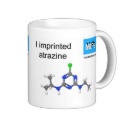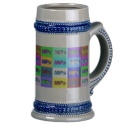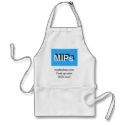|
|
Reference type: Journal
Authors: Cummins W, Duggan P, McLoughlin P
Article Title: Systematic cross-selectivity study of the factors influencing template receptor interactions in molecularly imprinted nitrogen heterocycles.
Publication date: 2006
Journal: Biosensors and Bioelectronics
Volume: 22
Issue: (3)
Page numbers: 372-380.
DOI: 10.1016/j.bios.2006.05.003
Alternative URL: http://www.sciencedirect.com/science/article/B6TFC-4KB14MG-1/2/33aad1b53742264730434ca309ce15d0
Abstract: A systematic cross-selectivity study involving a series of structurally related N-methylated and non-methylated substituted pyridines was performed with the aim of evaluating the parameters responsible for template receptor binding in molecularly imprinted polymers. Variation in binding of substrate structure permitted evaluation of the steric restraints of the imprinted cavity. The electrostatic effects, primarily hydrogen-bonding, were investigated through rebinding in chloroform and acetonitrile. All species were non-covalently imprinted in thermoinduced methacrylic acid-ethylene glycol dimethacrylate co-polymers. Evaluation of template properties indicate that a correlation exists between non-specific binding and template basicity for a series of structural isomers. A correlation between non-specific binding and hydrophobicity was also identified for templates increasing in alkyl character. However no overall correlation was observed, as it was speculated that these factors may be competing.All species imprinted, with the exception of 2-dimethylaminopyridine, produced a selective response for the template species. Varying degrees of cross-selectivity were observed for each imprinted polymer. Polymers imprinted with templates of higher basicity demonstrated a greater degree of cross-selectivity relative to those of lower basicity. While overall binding was reduced in acetonitrile relative to chloroform, specificity was increased. This highlights the intrinsic difference in binding sites within imprinted and non-imprinted sites of the polymer. Finally, while the ability of the template species to form a co-operative interaction may be advantageous in producing a selective imprint it is not a prerequisite. For species based on this co-operative interaction the steric environment in the immediate proximity to the binding functionalities are critical to recognition. Steric hindrance of non-functionally active groups can dramatically impair the formation of interactions
Template and target information: 2-aminopyridine, 2-apy, 2-methylaminopyridine, 2-mapy, 2-dimethylaminopyridine, 2-dmapy, 2-picolylamine, 2-pic, 3-aminopyridine, 3-apy, 3-picolylamine, 3-pic, 4-aminopyridine, 4-apy, 4-methylaminopyridine, 4-mapy, 4-dimethylaminopyridine, 4-dmapy, 4-picolylamine, 4-pic
Author keywords: molecular imprinting, Aminopyridine, Basicity, hydrophobicity, Cross-selectivity
|


 atrazine template mug ball and stick model
atrazine template mug ball and stick model







 multi MIPs logo beer stein
multi MIPs logo beer stein







 mips logo apron
mips logo apron






